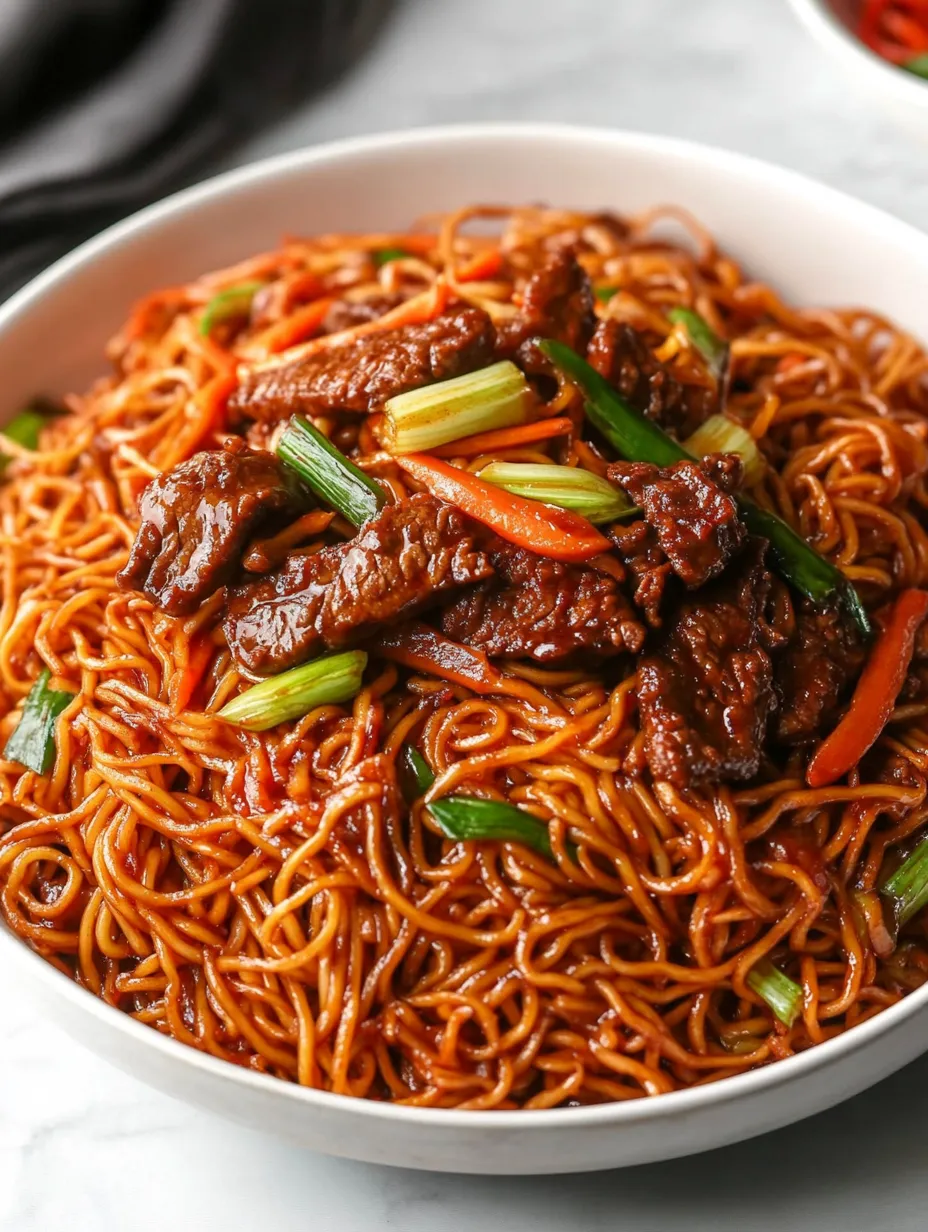 Pin
Pin
This filling beef chow mein brings the true taste of Chinese eateries straight to your kitchen with little fuss. The mix of soft marinated beef, crunchy veggies, and stretchy noodles makes a complete dish that hits the spot when you want takeout flavors without waiting or spending too much.
I whipped up this chow mein one night when I wanted Chinese food but didn't feel like ordering in. My family couldn't believe how much it tasted like the real thing, and now it's what we make when we want something fast but still wow-worthy.
What You'll Need
- Chow mein noodles: Go for fresh ones to get that real stretchy bite that makes chow mein special
- Flank steak: Cut it thin across the grain so it stays tender and cooks fast
- Mung bean sprouts: They give that needed snap and lightness against the rich tastes
- Napa cabbage: Adds a bit of sweetness and soaks up all the yummy sauce
- Carrots: Cut into thin strips for a pop of color and light sweetness
- Green onions: Give a fresh kick and classic finish
- Vegetable oil: Lets you cook hot without adding weird flavors
- Marinade items: Turn plain beef into tasty, soft bites. The baking soda is key as it makes meat tender through a method called velveting.
- Sauce stuff: Mixes sweet, salty and deep flavors for that genuine taste. Dark soy makes it look right while regular soy adds saltiness.
Easy Cooking Guide
- Prep Your Beef:
- Mix together cold water, cornstarch, oil, soy sauce and baking soda with your thin beef slices and let them sit for at least 15 minutes out on the counter. The baking soda softens the meat while cornstarch forms a shield that keeps juices in during hot cooking.
- Mix Your Sauce:
- Stir oyster sauce, both kinds of soy sauce, Shaoxing wine, sugar, sesame oil, cornstarch, crushed garlic and chicken stock in a bowl until smooth. Getting this ready first means you won't be rushing to measure stuff once your pan gets hot.
- Quick-Cook the Noodles:
- Get water bubbling in a big pan or wok. Drop in the chow mein noodles and cook just until they come apart, about 20 seconds. Drain right away and shake off water. They're meant to be undercooked since they'll finish in the sauce later.
- Brown the Meat:
- Heat 1 tablespoon oil in a wok or large skillet until it's really hot. Spread the soaked beef in one layer and don't touch it for 30 seconds. Then stir it around until the edges look brown but it's still juicy inside, about 1–2 minutes total. Put it on a plate for now.
- Cook Your Veggies:
- Put another tablespoon of oil in the same pan. Toss in carrots and cabbage, stirring fast for half a minute until they just start to soften but stay crisp. Push them to one side to make space for noodles.
- Bring It All Together:
- Add the last bit of oil to the empty spot in the pan. Toss in the partly cooked noodles and pour your sauce over them. Keep flipping and mixing with two tools to coat everything evenly, about a minute until noodles soak up most of the sauce. Add the beef back in along with bean sprouts and green onions. Mix everything for a final 30 seconds until hot and well combined.
 Pin
Pin
Good To Know
This dish packs plenty of protein and gives you a full range of nutrients. You can get ahead by cutting veggies and making sauce the night before. It's also great for using up random veggies hiding in your fridge.
The baking soda in the beef soak is my top trick for getting restaurant-quality meat. I picked up this method from a Chinese cook who told me how it breaks down tough fibers in cheaper beef cuts. The first time I tried it, I couldn't believe how soft the meat got even with just a short soak time.
Picking The Right Noodles
Real chow mein needs the right kind of noodles. Try to find fresh yellow egg noodles marked "chow mein" or "Hong Kong style" in the cold section at Asian stores. These noodles have that special bounce that makes chow mein stand out from other noodle dishes. If you can't get those, dry egg noodles will work too, though they'll feel a bit different. Skip spaghetti or other Western noodles as they don't have the right chew or starch level.
Getting That Special Smoky Taste
The smoky flavor you love in restaurant chow mein comes from a special cooking method and super high heat known as "wok hei." To copy this at home, make sure your pan is smoking hot before you add food and work fast. Let things sit briefly to brown before you stir them to build those sweet-savory flavors. Home stoves usually can't get as hot as restaurant ones, so cook smaller amounts at once and move quickly. The short cooking times in this recipe help keep that tasty seared quality.
Make It Your Way
This dish works as a great starting point for changes. You can swap beef for chicken, pork, shrimp or tofu if you want different protein. For a veggie version, throw in more vegetables and use veggie stir fry sauce instead of oyster sauce. The veggies are flexible too. Try adding mushrooms for rich flavor, snow peas for sweetness, or water chestnuts for extra crunch. Just keep the amounts of noodles, proteins and veggies balanced for the best texture and taste.
 Pin
Pin
Fixing Common Problems
Noodles turn mushy when you cook them too long at first or let them sit in sauce too long. Just blanch them until they come apart and make sure your wok is hot enough so the sauce thickens quickly instead of steaming the noodles. If your noodles stick together, a quick cold water rinse after the first cooking helps pull them apart before stir frying. Got sauce that's too thick? Add a spoon of water. Too thin? Mix a bit of cornstarch with cold water and stir it in bit by bit.
FAQs About the Recipe
- → Can I swap for different noodles?
Sure, try lo mein noodles or regular spaghetti if you can't find fresh chow mein noodles.
- → How can I make this without meat?
Just use tofu or throw in more veggies, and grab some mushroom or veggie oyster sauce instead.
- → What works instead of Shaoxing wine?
Dry sherry, regular white wine, or even some chicken broth will add similar depth.
- → How do I stop noodles from clumping?
Just mix a tiny bit of oil through them after you've cooked them.
- → Can I get this ready beforehand?
You can chop everything ahead of time, but cook it all fresh for the best results.
